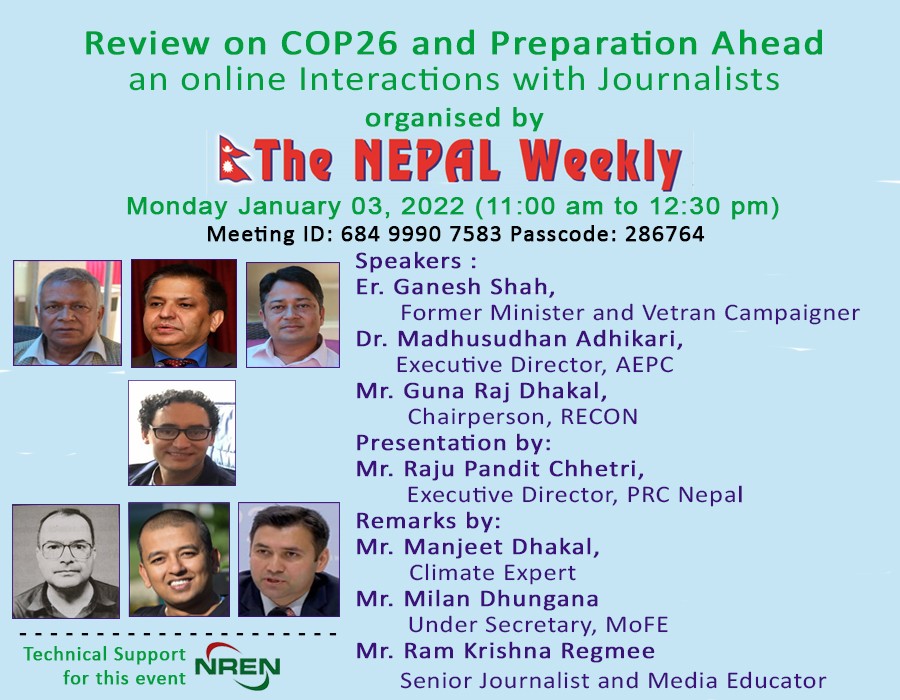PM addresses virtual programme
 The Nepal Weekly
The Nepal Weekly  January 18, 2022
January 18, 2022There was a great catastrophe in Nepal on January15, 1934 AD (Magh 2, 1990 BS). That was an 8.0 M earthquake.
Earthquake in Nepal is somehow a continued process. Nepal is at risk of earthquakes, the main reason for the formation of mountain ranges is the movement of tectonic plates. The remains of Shaligram and other sea creatures found in Nepali mountain ranges have proved that there was an ocean in that place thousands of years ago.It has been confirmed that there is the Tethys Sea in that place and the formation of a mountain range due to the movement of tectonic plates over thousands of years. Due to this geographical situation, Nepal has always been at risk of earthquakes.
Big earthquakes in Nepal return in 80 to 100 years. Several small scale earthquakes, however, taka place in between. The earthquake of 1934 was the big earthquake returned in 100 years. Yet again a big earthquake took place in year 2015.
Inthe year 1934 AD, there were not as many hospitals and facilities as there are now, many died without getting treatment! Many of these rivers and streams changed their course due to the earthquake, some of the water sources dried up and some new sources overflowed.
Earthquake is a natural disaster and even if it cannot be prevented, one can protect oneself from the possible dangers. Earthquakes do not kill us, but when an earthquake strikes, our houses and infrastructures are destroyed and our lives are lost. As such, earthquake-safe society and infrastructure should be given as a gift to the coming generation. Continuation of safe construction and vigilance campaigns must be done. Stay safe, stay protected.
As this day began to be celebrated, an earthquake with the epicentre of Barpak in Gorkha at 11:56 a.m. on April 25, 2015 (7.8 M) claimed the lives of about 9,000 people. More than eight million private homes were destroyed. More than 900 archaeological sites were destroyed. The quake affected Sindhupalchowk, Dolakha, Gorkha, Ramechhap, Okhaldhunga, Sindhuli, Kavrepalanchok, Makwanpur, Dhading, Nuwakot, Rasuwa, Kathmandu, Lalitpur, and Bhaktapur districts. The other 18 districts suffered partial damage.
Many people have lost their lives in the year 2015 AD earthquake and the wrong information and incorrectly built physical infrastructure are responsible for increased the death toll. Because of impractical and less logical imported information, such as hiding under a table, hiding under a bed, and living indoors, many could not save themselves even when they had time to escape.
National Earthquake Safety Day is observed on Magh 2 every year to commemorate the natural atrocities and damages caused by the nabbesaalko bhukampa (the big earthquake of 1934).
The day was celebrated under the slogan ‘Earthquake Awareness, Safe Structure’. This slogan has been decided with the objective of creating awareness among the people to make earthquake resistant structures that will not cause damage to human beings.
On this occasion, the Earthquake Safety Digital Exhibition was also organized through a virtual medium. On the occasion of the day, various organizations have been organizing programs to raise public awareness since January 9. As there is an epidemic of coronavirus this year, the programme will be conducted by maintaining physical distance and adopting health safety measures.
On the occasion of 24th National Earthquake Day on Sunday, Prime Minister Sher Bahadur Deuba has said that skilled manpower is ready for the construction of earthquake resistant building. He said that skilled manpower is prepared for the construction of earthquake resistant buildings in the country after the Earthquake of 2015. He has also requested the concerned bodies to mobilize skilled manpower.
Prime Minister Deuba has pointed out that the cooperation of all the three level governments is necessary for disaster mitigation. He said that special care should be taken while constructing weak structures, unmanaged urbanization and public and private buildings.
Prime Minister Deuba stressed the need for national and international assistance for disaster mitigation.

